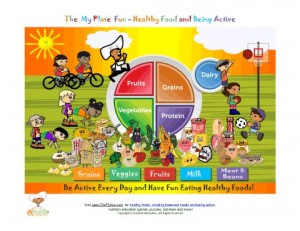
Parents of our school children are working with our elected School Board Trustees to bring physical education back to our elementary schools. This will be one of the subjects at the upcoming School Board meeting this Thursday July 24th at the SSFUSD District Office. Parents are rallying the community to attend this meeting in support of bringing this important California Ed Code mandated class back.
It is very concerning that the 2010 Census shows 47% of our SOUTH SAN FRANCISCO kids are obese. The life time health problems associated with obesity is nothing we would ever wish on our kids and by educating ourselves to these perils we can be more motivated to help change this course.
Physical Education offers kids not only the opportunity to release built up energy stored up through out the day, it teaches them teamwork, agility, and a life long appreciation for keeping their body in motion. One of our neighbors commented,
‘I believe that physical education is a lifestyle which must be promoted on an every day basis…… learning math through P.E. (distances/measurements, etc) It’s called applied hands-on learning for those folks in SSFUSD that are the decision makers.’
The habits and lessons we teach our youth will remain with them a life time. By setting the example and teaching our kids that daily physical activity is necessary we help them develop a healthy lifestyle. And it needs to be understood we cannot put all of this on the backs of our schools; parents must also step up and ensure kids learn the benefits of eating fresh veggies and fruit. It is all to easy to rely on processed convenient foods that offer ’empty calories’ with little to no health benefit. And we need to set the example ourselves since we know our little ones are mini-me’s and imitate our behavior.
Between a balanced curriculum that includes physical education and nutrition, supported and encouraged at home, we can reverse this trend of childhood obesity and all the associated health risks.
Childhood Obesity Facts From the CDC
- Childhood obesity has more than doubled in children and quadrupled in adolescents in the past 30 years.1, 2
- The percentage of children aged 6–11 years in the United States who were obese increased from 7% in 1980 to nearly 18% in 2012. Similarly, the percentage of adolescents aged 12–19 years who were obese increased from 5% to nearly 21% over the same period.1, 2
- In 2012, more than one third of children and adolescents were overweight or obese.1
- Overweight is defined as having excess body weight for a particular height from fat, muscle, bone, water, or a combination of these factors.3 Obesity is defined as having excess body fat.4
- Overweight and obesity are the result of “caloric imbalance”—too few calories expended for the amount of calories consumed—and are affected by various genetic, behavioral, and environmental factors.5,6
Health Effects of Childhood Obesity
Childhood obesity has both immediate and long-term effects on health and well-being.
Immediate health effects:
- Obese youth are more likely to have risk factors for cardiovascular disease, such as high cholesterol or high blood pressure. In a population-based sample of 5- to 17-year-olds, 70% of obese youth had at least one risk factor for cardiovascular disease.7
- Obese adolescents are more likely to have prediabetes, a condition in which blood glucose levels indicate a high risk for development of diabetes.8,9
- Children and adolescents who are obese are at greater risk for bone and joint problems, sleep apnea, and social and psychological problems such as stigmatization and poor self-esteem.5,6,10
Long-term health effects:
- Children and adolescents who are obese are likely to be obese as adults11-14 and are therefore more at risk for adult health problems such as heart disease, type 2 diabetes, stroke, several types of cancer, and osteoarthritis.6 One study showed that children who became obese as early as age 2 were more likely to be obese as adults.12
- Overweight and obesity are associated with increased risk for many types of cancer, including cancer of the breast, colon, endometrium, esophagus, kidney, pancreas, gall bladder, thyroid, ovary, cervix, and prostate, as well as multiple myeloma and Hodgkin’s lymphoma.15
Prevention
- Healthy lifestyle habits, including healthy eating and physical activity, can lower the risk of becoming obese and developing related diseases.6
- The dietary and physical activity behaviors of children and adolescents are influenced by many sectors of society, including families, communities, schools, child care settings, medical care providers, faith-based institutions, government agencies, the media, and the food and beverage industries and entertainment industries.
- Schools play a particularly critical role by establishing a safe and supportive environment with policies and practices that support healthy behaviors. Schools also provide opportunities for students to learn about and practice healthy eating and physical activity behaviors.